Nematodes act as beneficial insects against many plant pests. But what are nematodes and how do you use them correctly?
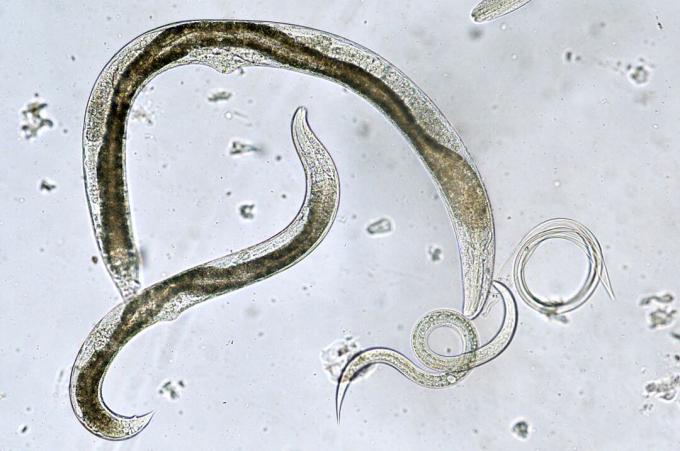
Nematodes offer the possibility of biological control of a large number of pests. When using nematodes, however, you should always keep in mind that they are living organisms. We will show you which pests you can use nematodes against and how to proceed correctly. In this article you will find all the information you need for a successful nematode operation.
contents
- Nematodes: Profile, Appearance & Co.
- Nematodes as beneficial insects
-
Application of nematodes: timing, procedure and duration of action
- Nematodes against fungus gnats
- Nematodes against vine weevil
- Nematodes against grubs
- Nematodes against ants
- Nematodes against snails
- Roundworms against other pests
Nematodes: Profile, Appearance & Co.
Nematodes, also known as nematodes, are translucent to white in color and cannot be seen with the naked eye. Over 20,000 different species are known to date. Depending on the species, nematodes have very different properties. The small roundworms feed species-specifically on plants, bacteria, algae, fungi, predatory or dead animals, for example. Many are also parasitic, such as roundworms, trichinella, and whipworms, all of which are also nematodes.
The nematodes (Nematoda) relevant for plant cultivation are small threadworms that are less than one millimeter in size. Depending on the specialization of food intake, they can be harmful or beneficial to plants. Some species can infest vegetables and other plants as pests. If you have problems with nematodes, then our article will help you Nematodes as pests continue for sure.
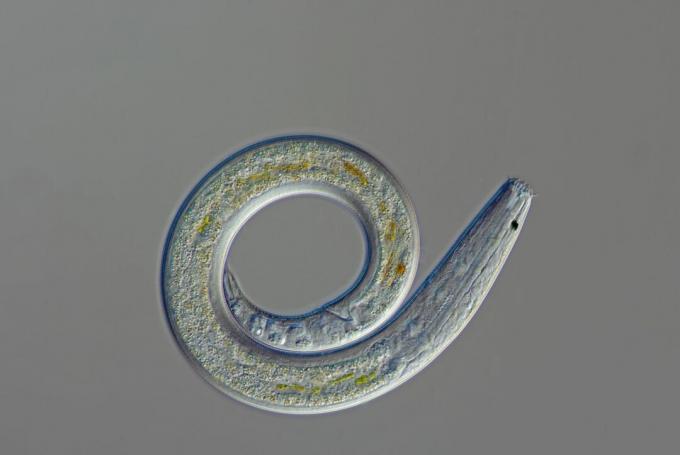
Nematodes as beneficial insects
So what makes some nematodes effective beneficial insects? Nematodes can actively move and spread in the soil. This ability gives the nematodes a greater chance of encountering prey in the garden. Their small size enables the nematodes to penetrate the interior of the pests via body openings and thus kill them. They then use the pest bodies to reproduce. Threadworms have many smaller allies when it comes to pest control: they are special bacteria that live in symbiosis with the nematodes. When a nematode and a suitable prey meet, the nematode injects the bacteria into the victim. These then digest the pest from the inside out - the nematode can then use the prey as food and multiply. The nematodes then leave the dead pest and look for a new host. In this way, the nematodes can remain in the soil for months under good conditions.
Another advantage is that the use of nematodes has no negative side effects for your plants or the environment. Incidentally, in almost all cases it is the pest larvae and not the adult pests that are attacked by the nematodes.
The great biodiversity of nematodes means that many different pests can be tackled, for example:
- fungus gnats
- vine weevil
- grubs
- ants
- snails
- cherry fruit flies
- box tree moth
- mole crickets
- thrips
- meadow cranefly
Application of nematodes: timing, procedure and duration of action
For a successful use of nematodes a few points should be considered:
- Before you can start using nematodes, it is important that you find out what the pest is. Only certain nematodes can be used against various pests.
- When is the right time of year to carry out a treatment with nematodes depends on the pest and the weather. Because if it is too cold or too dry, the nematodes are not active. Since usually only the larvae of the pest in the soil can be controlled, the time should be chosen so that the pest is in the larvae stage. Below we give you the best times to combat the most common pests.
- The soil temperature must be right for the respective nematode species. If the temperatures are too low, the nematodes stop their activity completely. Most species can be used at a soil temperature between 12 and 28 °C.
- Nematodes are sensitive to UV light. For this reason, you should avoid spreading the roundworms during the day. The evening or early morning is better.
Where to buy nematodes You can purchase various nematodes on the Internet in specialized shops or by ordering cards from garden centers. Also in ours Plantura online shop you can order three different nematode species that are effective against the most common pests. You will then receive the nematodes directly in your mailbox as durable permanent larvae in a powder that serves as a carrier.
In order to maintain this dormant state, it is important that you store the nematodes in the refrigerator until use. You can find out how long you can store the nematodes on the product packaging. Our Plantura nematodes can be stored for up to 6 weeks before use.
What is the correct procedure when using nematodes? Mix the powder containing the nematodes with water. The exact mixing ratio can be found on the product packaging. You should moisten the area to be treated well with water before applying the nematodes. The suspension can now be spread evenly over the area to be treated using a watering can. You can also read about the size of this area on the product packaging. After application, you should rinse the treated area with water to flush the nematodes into the soil. While the nematodes are doing their work, you should make sure that the soil is always moist. However, waterlogging must be avoided at all costs.

Tip: In the case of pests with development cycles spanning several years, such as garden beetles or mole crickets, we recommend using the nematodes for several years in a row.
What about the duration of action of nematodes? You can find the first dead larvae in the soil after just a few days. The introduced nematodes are in the soil for several months under very good conditions, but their number is steadily decreasing. Optimal pest control is only given in the first four weeks after application.
Tip: For example, if larvae of the vine weevil (Otiorhynchus) have been successfully infested and killed by nematodes, they turn red-brown. This allows you to check whether the application worked.
Summary: How to properly use nematodes
- The time of treatment depends on the pest and can be found in the package leaflet.
- The floor temperature must be permanently between 12 and 28 °C.
- Apply the nematodes in the morning or evening.
- Mix the acquired powder with water together with nematodes.
- Apply the nematodes to the moistened soil with the watering can and then water them in.
- Keep the soil moist for at least two weeks to encourage nematodes.
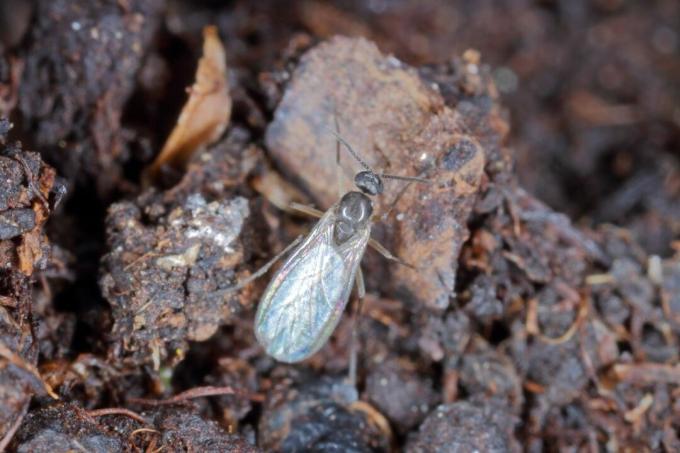
Nematodes against fungus gnats
The adult fungus gnats (Sciaridae) actually do not damage any plants. However, the larvae of the fungus gnat stay in the ground and feed, among other things, on young roots. In this way, the larvae can harm the plants. Indoor plants in particular are often attacked by fungus gnats. Helpful tips on the topic Fight fungus gnats we have put together for you in our article.
The nematode species Steinernema feltiae (SF nematodes) has proven effective against fungus gnats. Steinernema feltiae can be used on indoor plants all year round and outdoors from a soil temperature of 12 °C. Our Plantura SF nematodes we present it to you in more detail on this page.
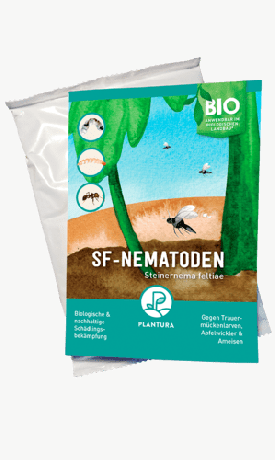
Plantura SF nematodes
Steinernema feltiae nematodes
for the biological and effective control of fungus gnats, codling moths and ants
In the case of a severe infestation or if you want to be on the safe side, we recommend using it in combination with a biological agent based on neem oil. Our Plantura Organic Fungus Gnat Free Neem allows you to get rid of fungus gnats naturally.
Nematodes against vine weevil
Even vine weevil, more precisely their larvae in the soil, can be combated by nematodes. So that rhododendron (rhododendron), ivy (Hedera helix), hydrangeas (Hydrangea) and other plants are spared from the dreaded vine weevil feeding, HB nematodes can be used. The nematode species Heterorhabditis bacteriophora can be applied from a soil temperature of 12 °C and is used for reliable and biological control of the vine weevil. We recommend using our Plantura HB nematodes between April and May or alternatively between August and September. More information about Vine weevil control by nematodes can be found in our special article.
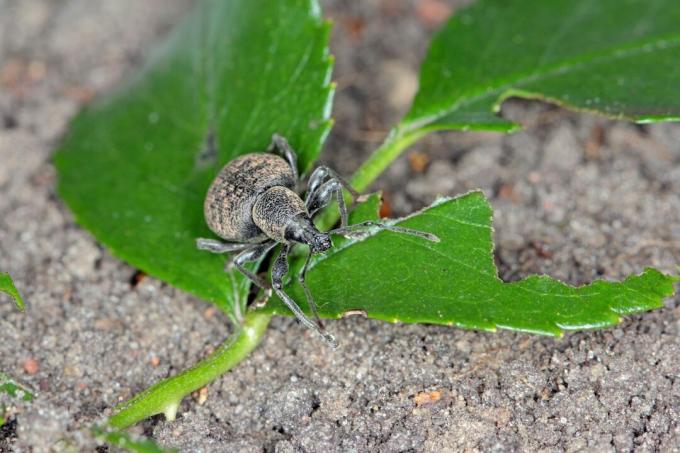
Nematodes against grubs
grubs are the larvae of scarab beetles such as June beetles (Amphimallon solstitiale), cockchafer (Melolontha melolontha) or rose chafer (Cetoniinae). They can cause damage if they multiply in large numbers on lawns. The complete and permanent control of grubs can sometimes take years with the stubborn larvae - especially with the May beetle. The reason for this lies in the many larval stages of grubs, not all of which are susceptible to the effects of pesticides
A biological control option is the use of HB nematodes against May beetle, June beetle and rose beetle larvae. Since only the first two young growth stages of grubs are effectively controlled, the timing of control is very important, as is the right nematode species: Heterorhabditis bacteriophora can be used between July and September against grubs of June beetles, garden chafers and tumble beetles.
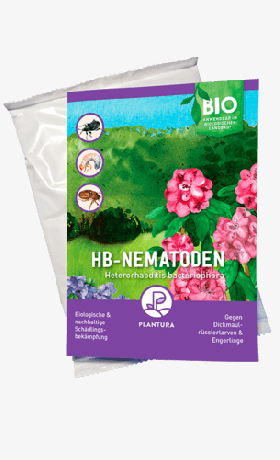
Plantura HB nematodes
Nematodes of the species Heterorhabditis bacteriophora
for the biological and effective control of vine weevils and grubs
Nematodes against ants
ants are actually not pests and are part of a healthy garden. But if you get the upper hand on terraces or paths, you may have to fight them. In this case, just like fungus gnats, you can use our Plantura SF nematodes the kind Steinernema feltiae insert. The nematodes disturb the ants, causing them and their brood to leave the treated area.

Ants can be particularly annoying indoors. When fighting ants in your home, we recommend that you use a biological agent. A particularly harmless agent for humans and animals is ours, for example Plantura ant control InsectoSec®, which uses pure kieselguhr as an active ingredient.
Nematodes against snails
As every hobby gardener knows, Slugs in the garden cause significant damage. Also for Fighting snails you can use nematodes. The special advantage: snails multiply particularly strongly in damp weather. The nematodes also need moist conditions to thrive.
In order for the fight against snails to be effective, you should use the nematode type Phasmarhabditis hermaphrodita To fall back on. The optimum soil temperature is between 12 and 25 °C. Another advantage is that the harmless Roman and house snails are spared.
Roundworms against other pests
The nematode Steinernema feltiae works not only against fungus gnats and ants, but also against the larvae of the cherry fruit fly. However, the effect is not nearly as good as with the fungus gnat. The cherry fruit fly larvae can only be fought at the moment when the larvae migrate from the infested cherry into the soil. Therefore, the nematodes must be applied to the soil in such a way that they are actively present in the soil during this period. A good time to do this is early June.
To nematodes against the box tree moth to be able to use the nematodes must be integrated into a specific wetting agent. This is the only way for them to come into direct contact with the larvae of the box tree moth.
The nematode species Steinernema carpocapsae is suitable for combating box tree moths. You will find precise information on the correct application on the product packaging. The optimal treatment time is two weeks after you have discovered the first adult animals. To determine this point in time, we recommend a borer trap.
For an effective and environmentally friendly fight against the box tree moth, we can also offer you a remedy based on the also living Bacillus thuringiensis recommend. A similar means is ours, for example Plantura Zünslerfrei XenTari®.
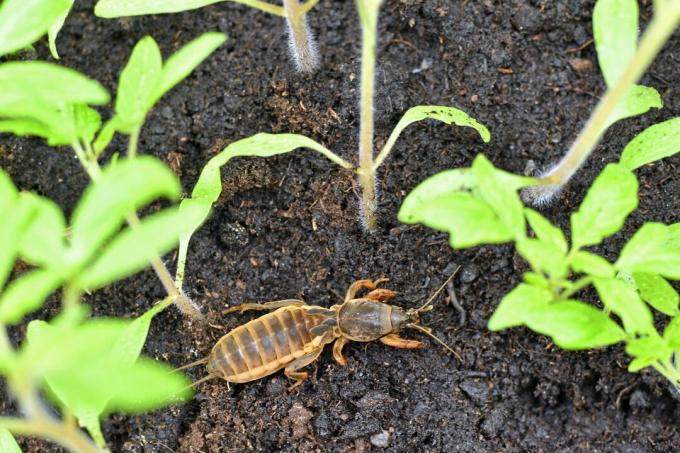
Too large a number of mole crickets (Gryllotalpidae) can be very annoying in the vegetable patch. The nematode species Steinernema carpocapsae can be used against mole crickets. Here, the adult animals are infested and killed. The optimal period for combating is between March and July from a soil temperature of 12 °C.
meadow cranefly can be a problem, especially in the lawn. A biological control is with our Plantura SC nematodes possible against meadow gnats. The larvae of the meadow gnat are caused by the nematode species Steinernema carpocapsae killed. The best time to fight is about two weeks after the high point of the crane fly's flight, between September and October.
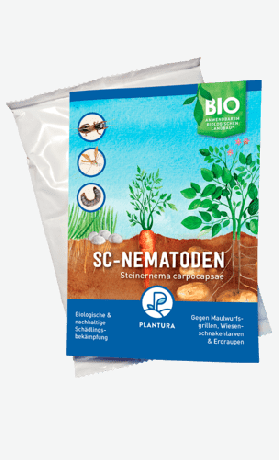
Plantura SC nematodes
Steinernema carpocapsae nematodes
for the biological and effective control of mole crickets, meadow gnats and cutworms
Nematodes can also fight thrips (Thysanoptera) are used. The flower thrips (Frankliniella occidenalis) is one of the most common species and is particularly a problem in greenhouses or in living quarters. Steinernema feltiae infects the flower thrips pupa and kills it. The fight can therefore take place all year round.
In addition to nematodes, there are a whole range of other animal helpers that will help you keep pests in check in the garden. More exciting Beneficial insects in the garden we present to you in our overview article.
...and receive concentrated plant knowledge and inspiration directly in your e-mail inbox every Sunday!



